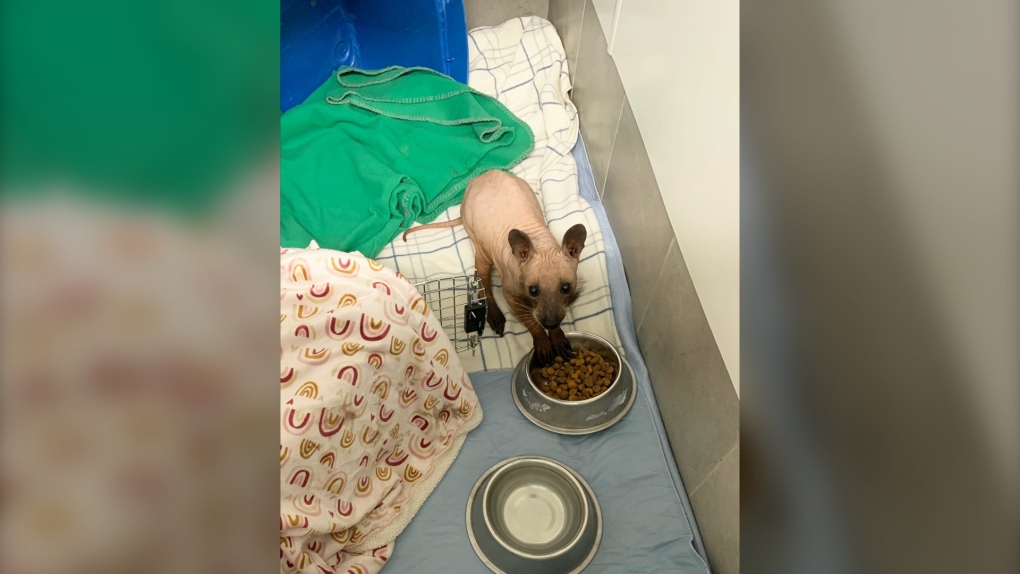Nova Scotia's Hope For Wildlife welcomes 'completely bald' raccoon
Hope For Wildlife, a wildlife rehabilitation centre in Seaforth, N.S., has recently taken an animal into its care and its appearance may have some people doing a double take.
The centre posted photos of a northern raccoon with what is believed to be alopecia – otherwise known as hair loss – on its Facebook page Wednesday morning.
The animal is described as “completely bald" in addition to being “not friendly” and “feisty.”
The post says the animal is a female, though Hope Swinimer, the founder and director of Hope for Wildlife, later referred to it as a male.
She says the centre received a call from people in Cape Breton who discovered the animal, but they weren’t sure what it was at first.
“Once we got a live trap and were able to bring him in, it was clear that he was a raccoon, but he’s a bald raccoon," Swinimer says.
Swinimer says she has only see two bald raccoons in the 25 years she has been doing wildlife work.
“We don’t see it very often, but in every species we do get cases in where the animals come in bald, but it might happen once a year,” she says.
 A bald raccoon is pictured at Hope For Wildlife, a wildlife rehabilitation centre in Seaforth, N.S. (Source: Facebook/Hope For Wildlife)
A bald raccoon is pictured at Hope For Wildlife, a wildlife rehabilitation centre in Seaforth, N.S. (Source: Facebook/Hope For Wildlife)
Hope For Wildlife says the critter could have an autoimmune disorder, though it hasn’t been fully diagnosed yet.
“We’re going to sedate him over the next couple of days, there’s no big hurry because he’s healthy, and just do some skin scraping, maybe a biopsy just to be sure it’s something genetic, like alopecia, something like that,” says Swinimer.
The wildlife rehabilitation centre says it is “amazed” the animal was able to live through the winter without any injuries -- or fur.
“How this little guy lived through the whole winter without any fur, I don’t know," Swinimer says. "He would of succumbed to the temperatures if he wasn’t probably sleeping away a lot of the winter and not coming out very often, but he looks really healthy.”
But can the animal go back to the wild without fur? Swinimer says it’s hard to say.
“I think the long-term prognosis is good,” she says. “However, he may not be able to have a typical life in the wild.”
 A raccoon with alopecia has a bite to eat at a wildlife rehabilitation centre in Seaforth, N.S. (Source: Facebook/Hope For Wildlife)
A raccoon with alopecia has a bite to eat at a wildlife rehabilitation centre in Seaforth, N.S. (Source: Facebook/Hope For Wildlife)
For now, the raccoon has been given the name "Rufus" by one of Hope For Wildlife's staff members after the naked mole-rat character on Kim Possible, a Disney TV series.
Hope For Wildlife is no stranger to interesting raccoons – they’ve previously welcomed several albino ones.
For more Nova Scotia news visit our dedicated provincial page.
CTVNews.ca Top Stories

More than 115 cases of eye damage reported in Ontario after solar eclipse
More than 115 people who viewed the solar eclipse in Ontario earlier this month experienced eye damage after the event, according to eye doctors in the province.
Toxic testing standoff: Family leaves house over air quality
A Sherwood Park family says their new house is uninhabitable. The McNaughton's say they were forced to leave the house after living there for only a week because contaminants inside made it difficult to breathe.
Decoy bear used to catch man who illegally killed a grizzly, B.C. conservation officers say
A man has been handed a lengthy hunting ban and fined thousands of dollars for illegally killing a grizzly bear, B.C. conservation officers say.
B.C. seeks ban on public drug use, dialing back decriminalization
The B.C. NDP has asked the federal government to recriminalize public drug use, marking a major shift in the province's approach to addressing the deadly overdose crisis.
OPP responds to apparent video of officer supporting anti-Trudeau government protestors
The Ontario Provincial Police (OPP) says it's investigating an interaction between a uniformed officer and anti-Trudeau government protestors after a video circulated on social media.
An emergency slide falls off a Delta Air Lines plane, forcing pilots to return to JFK in New York
An emergency slide fell off a Delta Air Lines jetliner shortly after takeoff Friday from New York, and pilots who felt a vibration in the plane circled back to land safely at JFK Airport.
Sophie Gregoire Trudeau on navigating post-political life, co-parenting and freedom
Sophie Gregoire Trudeau says there is 'still so much love' between her and Prime Minister Justin Trudeau, as they navigate their post-separation relationship co-parenting their three children.
Last letters of pioneering climber who died on Everest reveal dark side of mountaineering
George Mallory is renowned for being one of the first British mountaineers to attempt to scale the dizzying heights of Mount Everest during the 1920s. Nearly a century later, newly digitized letters shed light on Mallory’s hopes and fears about ascending Everest.
Loud boom in Hamilton caused by propane tank, police say
A loud explosion was heard across Hamilton on Friday after a propane tank was accidentally destroyed and detonated at a local scrap metal yard, police say.































